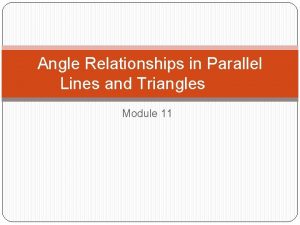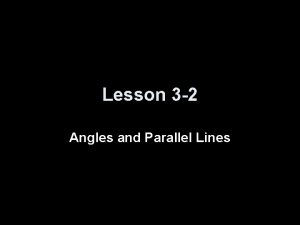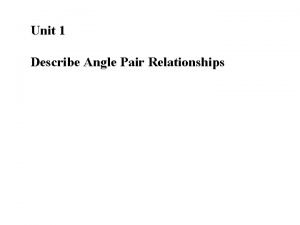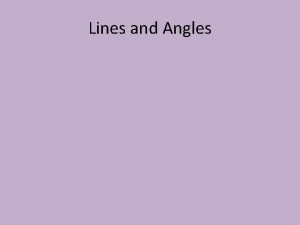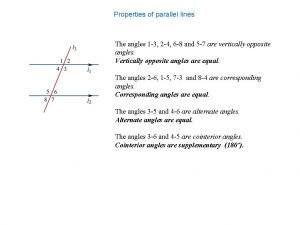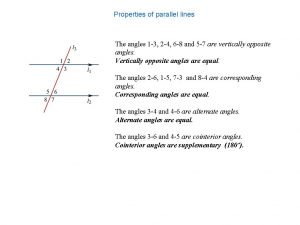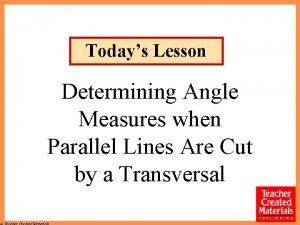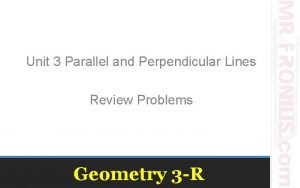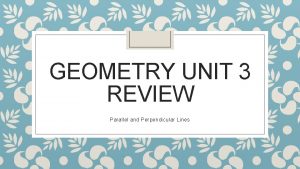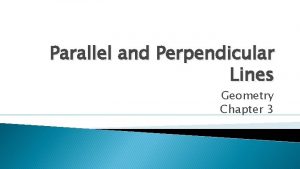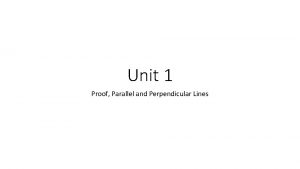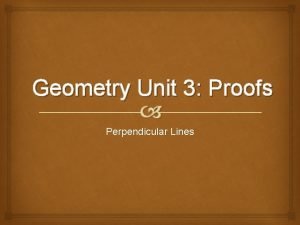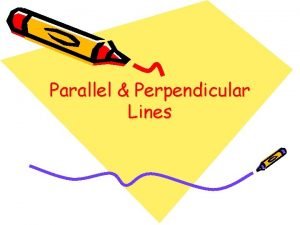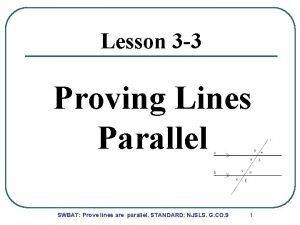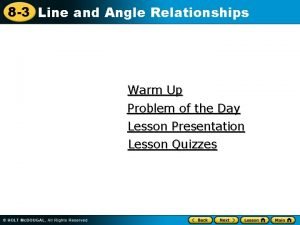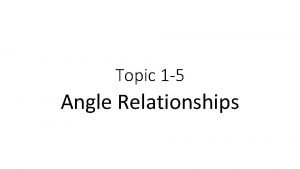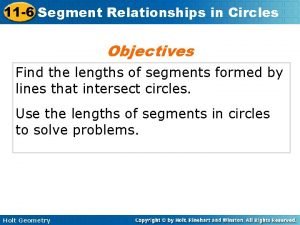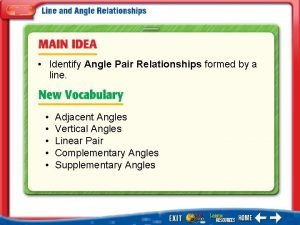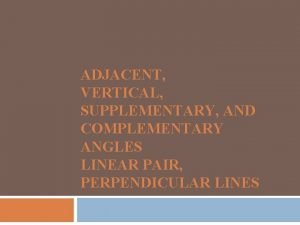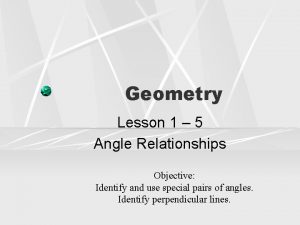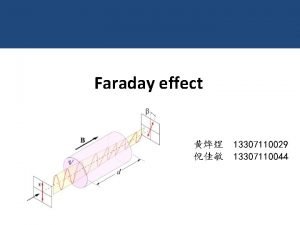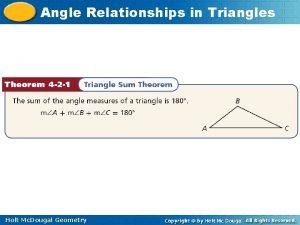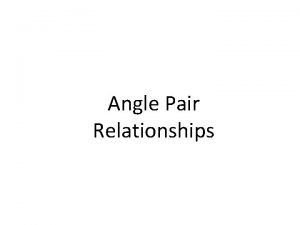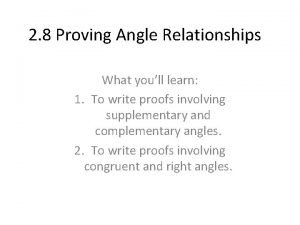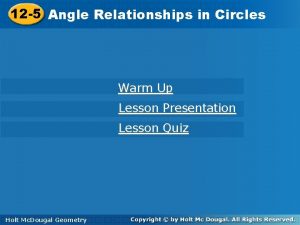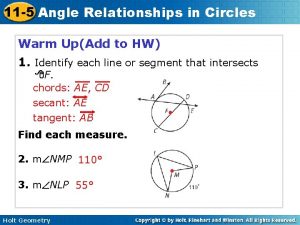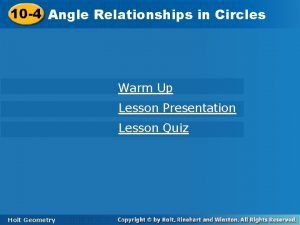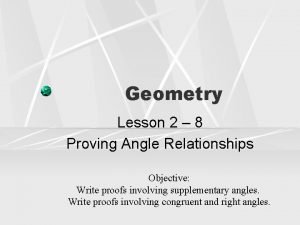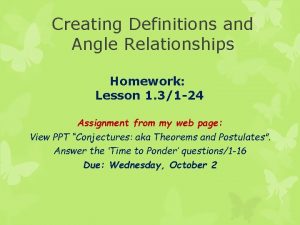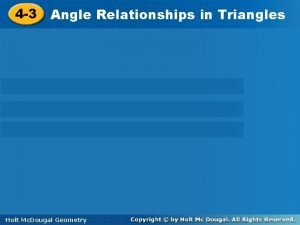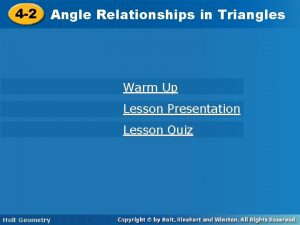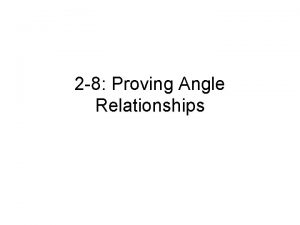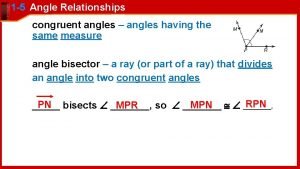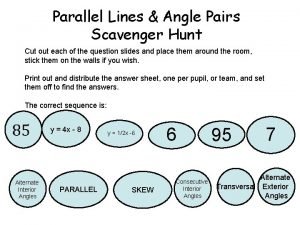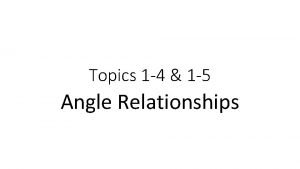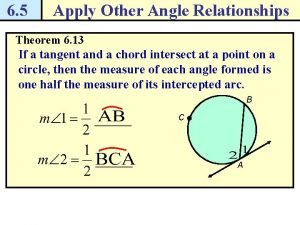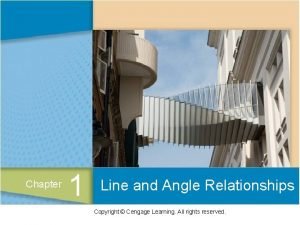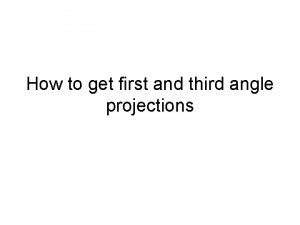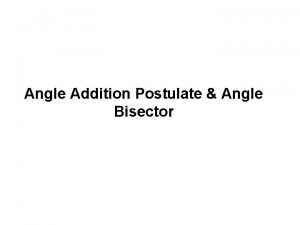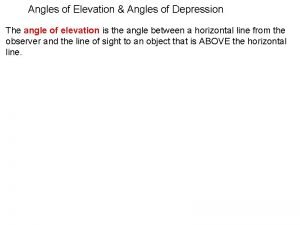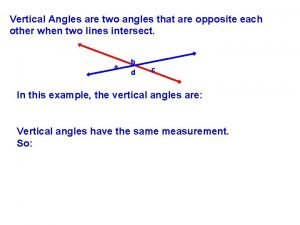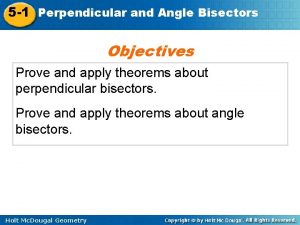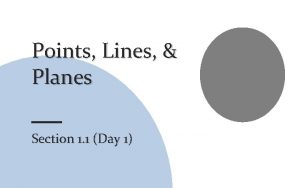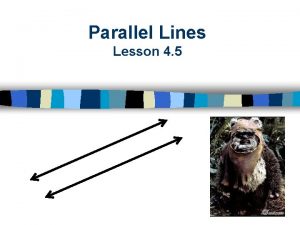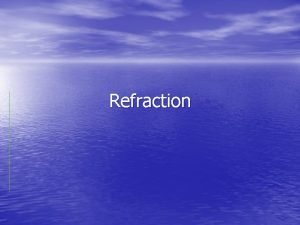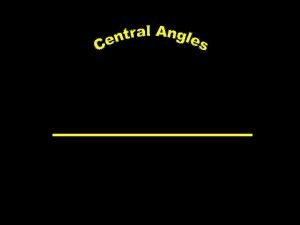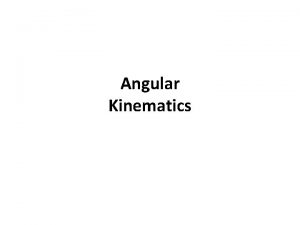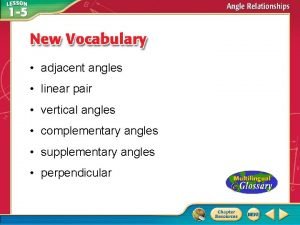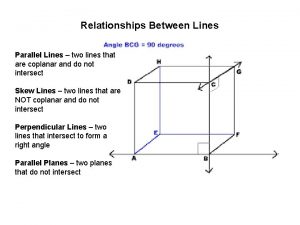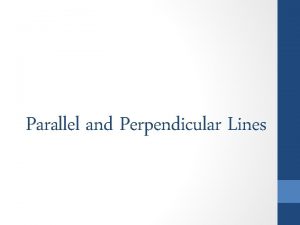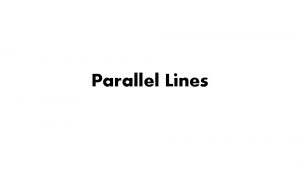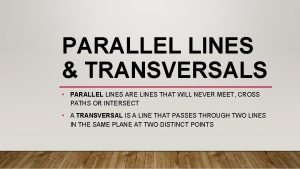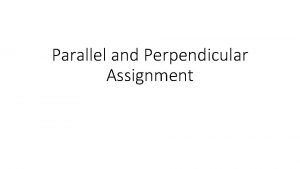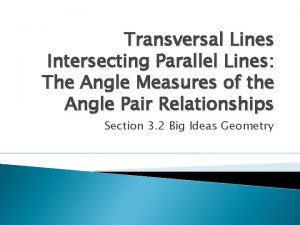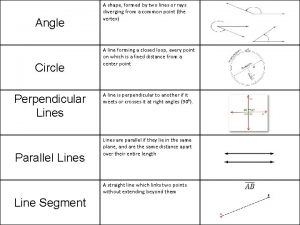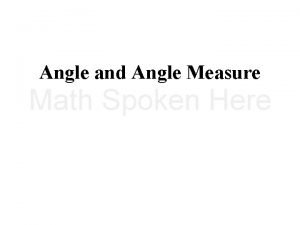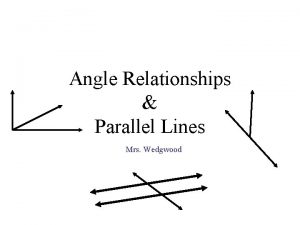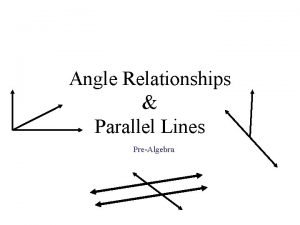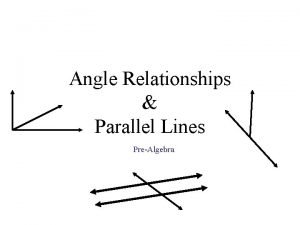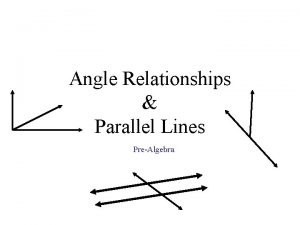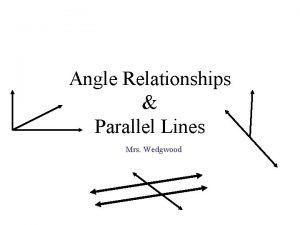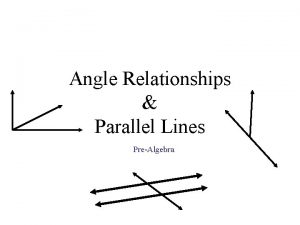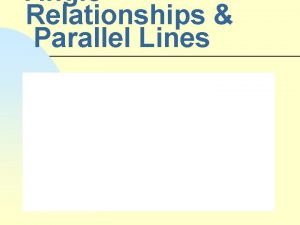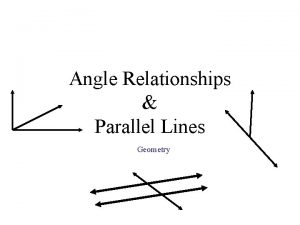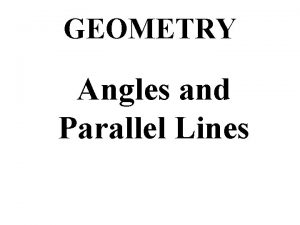Unit 2 Parallel Lines and Angle Relationships Parallel




































































- Slides: 68

Unit 2 Parallel Lines and Angle Relationships

Parallel Lines Two lines that do not intersect are either parallel or skew. Parallel Lines (II lines) are coplanar lines that do not intersect. Skew Lines are non coplanar lines. Therefore, they are neither parallel nor intersecting.

Parallel Segments/Rays Sketch the following specific conditions: Segments and rays contained in parallel lines are also called parallel. If two segments do not have an intersection point, but are contained in intersecting lines, we do not call the segments parallel.

Parallel Planes Two planes that do not intersect are called parallel planes. A line and a plane are parallel if they do not intersect.

Exercises!

Exercises!

Exercises!

Exercises!

Exercises! Theorem: If two parallel planes are cut by a third plane, then the lines of intersection are parallel. Given: Plane A ‖ Plane B Plane A intersects plane C in line x Plane B intersects plane C in line y Prove: line x ‖ line y To show two lines are parallel, what do we need to know? Statement Reason

Transversal A line that intersects two or more coplanar lines at different points 1 4 5 8 6 7 2 3

Angles Formed by Two Lines and a Transversal 1 3 5 7 2 1) Corresponding angles (corr <s) – two angles that have corresponding positions relative to the two lines. 4 6 2) Alternate interior angles (alt. int. <s) – two nonadjacent interior angles on opposite sides of the transversal. 8 3) Same-side Interior (SSI <s) – two interior angles on the same side of the transversal. Interior vs Exterior Angles

Learning Log Summary LT 1 - I can classify pairs of angles and lines using appropriate vocabulary. Parallel and skew lines are different because… Pairs of angles formed when two lines are intersected by a transversal are…

Closure Homework pg. 76 ~ 1 -39 (odd)

Constructions • Perpendicular Bisector • Note: Copy segment AB first (to move it higher up) • Reflect: How can you use a ruler and protractor to check the construction? • A perpendicular to a Line • Reflect: Does the construction still work if point P is on line m? Why or why not? • Constructing Parallel Lines • Reflect: Why does it make sense to copy angle PQR to get a line parallel to line m? • Reflect: Is it possible to construct a line parallel to a give line m that passes through a point P that is on line m? Why or why not?

Right Angle Congruence Theorem: All right angles are congruent. Given: and are right angles. Prove: Statements A Reasons B

Theorem 3 -9 Through a point outside a line, there is exactly one line perpendicular to the given line.

Group Task Prove one of the relationships that exist among angles formed when parallel lines are cut by a transversal. • What is a transversal? • What is the difference between inductive and deductive reasoning? • Use inductive reasoning to determine what relationship exists between corresponding angles.

Corresponding Angle Postulate If l is parallel to m , then. Why is this a postulate instead of a theorem?

Group Task

Gallery Walk

Alternate Interior Angle Theorem If l is parallel to k, then…

Same Side Interior Angle Theorem If l is parallel to m , then…

Theorem 3 -4 (Perpendicular Transversal Thm) If k is parallel to l and then… ,

Theorems Handout Record theorems onto your theorem handout. Alternate Interior Angles Theorem Same Side Interior Angles Theorem 3 -4

Learning Log Summary LT 2 - I can use previous definitions, properties and postulates to prove angle relationships when parallel lines are cut by a transversal. The postulate necessary to prove other angle relationships is… To prove relationships among SSI/alt int angles… If a transversal is perpendicular to one parallel line, then…

Theorem 3 -8 Through a point outside a line, there is exactly one line parallel to the given line.

Corresponding Angle Postulate If l is parallel to m , then corresponding angles are congruent. Why is this a postulate instead of a theorem?

Converse to Corresponding Angle Postulate If corresponding angles are congruent, then l is parallel to m. Why is this a postulate instead of a theorem?

Recall: Supplementary Angle Theorem If two angles are supplementary to the same angle, then they are congruent. Complementary Angle Theorem If two angles are complementary to the same angle, then they are congruent.

Converse to Alternate Interior Angle Theorem Record it on your list!

Converse to Same-Side Interior Angle Theorem Record it on your list!

Converse to Perpendicular Transversal Theorem Record it on your list!

Converse to Perpendicular Transversal Theorem

Learning Log Summary LT 3 - I can apply theorems about angles formed when parallel lines are cut by a transversal to solve problems. The theorem(s) that allow me to make conclusions about angles formed by two lines and transversal are… What’s a theorem you had a difficult time applying or remembering? Record that with a picture or summarize in your own words.

Learning Log Summary LT 4 - I can use previous definitions, properties and postulates to prove that lines are parallel, given specific relationships that exist between the angles formed. The ways to prove that two lines are parallel… The angle relationship you establish also establishes the parallel lines and the transversal because…

Recap: Ways to Prove Lines I I Show that… • • • Corr. angles are congruent Alt Int angles are congruent SSI angles are supplementary 2 lines are perpendicular to a 3 rd line Both lines are parallel to a 3 rd line

Learning Log Summary LT 5 - I can determine the appropriate conditions for lines in a diagram to be parallel. A strategy to break up the diagrams is… The type of angle relationships needed to prove lines parallel are…

Angles of a Triangle A triangle is formed by three segments joining noncollinear points. Each of the three points is a vertex of the triangle (the plural of vertex is vertices) The segments are the sides of the triangle.

Angles of a Triangle Name the following for Triangle ABC (ΔABC): Vertices: Sides: Angles:

Angles of a Triangle A triangle is sometimes classified by the number of congruent sides it has.

Angles of a Triangle A triangle is sometimes classified by its angles.

Learning Log Summary LT 6 - I can classify triangles based on information about their angles and sides and use this classification in a problem solving context. The ways to classify a triangle are… If a triangle is a right isosceles, then…

Angles of a Triangle An auxiliary line is a line (or ray or segment) added to a diagram to help in a proof. An auxiliary line is used in the next proof – one of the best-known in geometry!

Angles of a Triangle The sum of the measures of the angles of a triangle is 180. Given: ΔABC Prove: Statement Reason Record the Theorem!

Learning Log Summary LT 7 - I can prove that the sum of the interior angle measure of a triangle is 180. To prove the Interior Angles of a Triangle Theorem … An auxiliary line can be used for… The sum of the measures of the angles of a triangle is…

Angles of a Triangle A statement that can be proved easily by applying a theorem is often called a corollary. Draw and support one of the following corollaries with your partner by using a diagram and informal proof argument: • If two angles of one triangle are congruent to two angles of another triangle, then the third angles are congruent. • Each angle of an equiangular triangle has a measure of 60. • In a triangle, there can be at most one right angle or obtuse angle. • The acute angles of a right triangle are complementary.

Angles of a Triangle When one side of a triangle is extended, an exterior angle is formed as shown in the diagram. The measure of the exterior angle is always a supplement of the adjacent interior angle. The remote interior angles are interior angles that are non-adjacent to the exterior angle.

Angles of a Triangle Record the Theorem! The measure of an exterior angle of a triangle equals the sum of the measures of the two remote interior angles. Given: ΔABC Prove:

Learning Log Summary LT 8 - I can state and prove the relationships between an exterior angle of a triangle and the two remote interior angles The measure of an exterior angle of a triangle is… To prove the Triangle Exterior Angle Theorem…

Problem Solving and Classifying Triangles

Learning Log Summary LT 9 - I can use the relationships that exist among interior and exterior angles of triangles in a problem solving context.

Polygons A polygon (meaning “many angles”) is formed by coplanar segments called sides. • Each segment intersects exactly two other segments, each at one endpoint. • No two segments with a common endpoint are collinear.

Polygons A convex polygon is a polygon such that no line containing a side of the polygon contains a point in the interior of the polygon. Convex vs Concave

Polygons A regular polygon is a polygon that is both equiangular and equilateral.

Polygons When naming a polygon, we list its consecutive vertices in order. Hexagon ABCDEF

Polygons The diagonal of a polygon is a segment joining nonconsecutive vertices. How many diagonals does Hexagon ABCDEF have? How many diagonals does Hexagon ABCDEF have from a single vertex?

Polygons We want to use inductive reasoning to find an expression that yields the sum of the interior angles of a convex polygons.

Sum of the Interior Angles of a Polygon Theorem

Learning Log Summary LT 10 - I can explain, through inductive reasoning, the formula used to find the sum of the interior angles of a polygon. The sum of the interior angles of a convex polygon… The measure of one interior angle of a regular convex polygon…

Polygons We want to use inductive reasoning to find an expression that yields the sum of the exterior angles of a convex polygons.

Polygons What is the sum of the interior angles of a convex polygon with n sides? What is the measure of one interior angle of a regular convex polygon with n sides?

Learning Log Summary LT 10 - I can explain, through inductive reasoning, the formula used to find the sum of the interior angles of a polygon. The sum of the interior angles of a polygon… Inductive reasoning was used to…

Exterior Angles of Polygons Exterior angles are formed by a side and an extension of an adjacent side. Is there anything special about the sum of the exterior angles of a polygon? Let’s explore.

Polygons Using the table from “Interior/Exterior Angles of a Polygon” worksheet, complete columns F, G, and H. Then answer question #4 on the back. If a regular convex polygon has n sides, what is the measure of each exterior angle? How many exterior angles exist in a polygon with n sides?

Polygons What is the sum of the measures of the exterior angle of a regular convex polygon with n sides? Now answer homework question #7.

Record the Theorem! Sum of the Exterior Angles of a Polygon Theorem

Polygons Problem Solving with Interior and Exterior Angles of Polygons Hint: Sketch a pictures for #5 and 6. #8 Edit “measure of each interior angles” (just one angle, not multiple)

Learning Log Summary LT 11 - I can state and apply theorems involving the sum of the interior and exterior angles of polygons in problem solving contexts. The sum of the exterior angles of a polygon… The sum of the interior angles of a polygon… The sum of an adjacent pair interior and exterior angles of a polygon…
 Angle relationships in parallel lines and triangles
Angle relationships in parallel lines and triangles Lesson 3-7 parallel lines and transversals
Lesson 3-7 parallel lines and transversals Tell whether the indicated angles are adjacent
Tell whether the indicated angles are adjacent Define parallel lines and intersecting lines
Define parallel lines and intersecting lines Properties of angles in parallel lines
Properties of angles in parallel lines Parallel lines angles rules
Parallel lines angles rules 110/2
110/2 Unit 3 parallel & perpendicular lines answer key
Unit 3 parallel & perpendicular lines answer key Geometry unit 3 review
Geometry unit 3 review Chapter 3 parallel and perpendicular lines answers
Chapter 3 parallel and perpendicular lines answers Unit 1 proof parallel and perpendicular lines
Unit 1 proof parallel and perpendicular lines How to prove lines are perpendicular
How to prove lines are perpendicular The lines shown below are perpendicular
The lines shown below are perpendicular What are the two focal points of a loop?
What are the two focal points of a loop? 3-3 proving lines parallel answers
3-3 proving lines parallel answers Panjang sisi ac adalah
Panjang sisi ac adalah Topic 3 line and angle relationships
Topic 3 line and angle relationships Angle relationships jeopardy
Angle relationships jeopardy Definition of congruent segments example
Definition of congruent segments example Angle and segment relationships in circles
Angle and segment relationships in circles Which relationships describe the angle pair x° and 50º?
Which relationships describe the angle pair x° and 50º? Vertical angles
Vertical angles Angle relationships warm up
Angle relationships warm up Lesson 1-5 angle relationships answers
Lesson 1-5 angle relationships answers Alternate interior angles conjecture
Alternate interior angles conjecture Angle relationships error analysis
Angle relationships error analysis 1-4 exploring angle pairs
1-4 exploring angle pairs Different types of angle relationships
Different types of angle relationships Triangle angle relationships
Triangle angle relationships Pair relationship examples
Pair relationship examples 2-8 proving angle relationships
2-8 proving angle relationships 12-5 angle relationships in circles
12-5 angle relationships in circles Angle relationships circles
Angle relationships circles Angle relationships circles
Angle relationships circles Angle pair relationships
Angle pair relationships Angle relationships jeopardy
Angle relationships jeopardy 2-8 proving angle relationships
2-8 proving angle relationships Angle relationship definitions
Angle relationship definitions 4-3 angle relationships in triangles
4-3 angle relationships in triangles 4-2 lesson quiz geometry
4-2 lesson quiz geometry Proving
Proving Complementary angles have a sum of ____. *
Complementary angles have a sum of ____. * Angle relationships scavenger hunt answer key
Angle relationships scavenger hunt answer key 2-8 proving angle relationships
2-8 proving angle relationships 1-5 angle relationships
1-5 angle relationships Applying angle relationships
Applying angle relationships How to use an angle chapter 1
How to use an angle chapter 1 System of orthographic projection
System of orthographic projection Hand cutting instruments in operative dentistry
Hand cutting instruments in operative dentistry Angle klm and angle mln are a linear pair.
Angle klm and angle mln are a linear pair. Angle bisectors worksheet
Angle bisectors worksheet Angle addition practice answer key
Angle addition practice answer key Angle 1 and angle 2 are supplementary
Angle 1 and angle 2 are supplementary Angle of depression
Angle of depression -dot
-dot First orthographic projection
First orthographic projection Relationships of lines
Relationships of lines Lesson 5-1 perpendicular and angle bisectors
Lesson 5-1 perpendicular and angle bisectors Unit 6 review questions
Unit 6 review questions Why are lines ac and rs skew lines?
Why are lines ac and rs skew lines? Parallel lines and planes
Parallel lines and planes Convention of lines
Convention of lines Angle similarity
Angle similarity At what angle of incidence is the angle of refraction 90
At what angle of incidence is the angle of refraction 90 What is an angle whose vertex is the center of the circle
What is an angle whose vertex is the center of the circle Absolute angle vs relative angle
Absolute angle vs relative angle Name an angle or angle pair that satisfies each condition
Name an angle or angle pair that satisfies each condition In the diagram gh bisects ∠fgi
In the diagram gh bisects ∠fgi Extinction of minerals
Extinction of minerals
